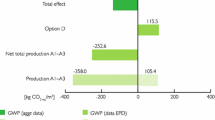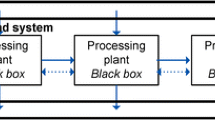Abstract
Purpose
One aim of LCA-based rating tools developed by the apparel industry is to promote a change in demand for textiles by influencing consumer preferences based on the environmental footprint of textiles. Despite a growing consensus that footprints developed using attributional LCA (aLCA) are not suitable to inform decisions that will impact supply and demand, these tools continue to use aLCA. This paper analyses the application of the LCA methods to wool production, specifically the application of aLCA methods that provide a retrospective assessment of impacts and consequential (cLCA) methods that estimate the impacts of a change.
Methods
Attributional and consequential life cycle inventories (LCIs) were developed and analysed to examine how the different methodological approaches affect the estimated environmental impacts of wool.
Results and discussion
Life cycle impact assessment (LCIA) of aLCI and cLCI for wool indicates that estimated global warming and water stress impacts may be considerably lower for additional production of wool, as estimated by cLCIA, than for current production as estimated by aLCIA. However, fossil resource impacts for additional production may be greater than for current production when increased wool production was assumed to displace dedicated sheep meat production.
Conclusions
This work supports the notion that the use of a retrospective assessment method (i.e. aLCA) to produce information that will guide consumer preferences may not adequately represent the impacts of a consumer’s choice because the difference between aLCIA and cLCIA results may be relatively large. As such, rating tools based on attributional LCA are unlikely to be an adequate indicator of the sustainability of textiles used in the apparel industry.

Similar content being viewed by others
References
Blackburn R (2009) Sustainable textiles: life cycle and environmental impact. Elsevier
Brandão M, Clift R, Cowie A, Greenhalgh S (2014) The use of life cycle assessment in the support of robust (climate) policy making: comment on “using attributional life cycle assessment to estimate climate-change mitigation…”. J Ind Ecol 18:461–463
Brander M (2017) Comparative analysis of attributional corporate greenhouse gas accounting, consequential life cycle assessment, and project/policy level accounting: a bioenergy case study. J Clean Prod 167:1401–1414
Brander M, Tipper R, Hutchison C, Davis G (2008) Technical paper: consequential and attributional approaches to LCA: a guide to policy makers with specific reference to greenhouse gas LCA of biofuels. Econometrica press
Cederberg C, Stadig M (2003) System expansion and allocation in life cycle assessment of milk and beef production. Int J Life Cycle Assess 8:350–356
Colby L (2015) World sheep meat market to 2025. AHDB Beef & Lamb
EU JRC (2010) ILCD handbook: general guide for life cycle assessment: detailed guidance. Publications Office of the European Union
European Commission (2013) Guidance for the implementation of the EU Product Environmental Footprint (PEF) during the Environmental Footprint (EF) pilot phase European Commission
FAO (2016) OECD-FAO Agricultural Outlook 2016-2025, Commodity snapshots: Meat. United Nations Food and Agriculture Organisation
FAO (2017) Meat consumption. United Nations Food and Agriculture Organisation
Finnveden G, Hauschild MZ, Ekvall T, Guinée J, Heijungs R, Hellweg S, Koehler A, Pennington D, Suh S (2009) Recent developments in life cycle assessment. J Environ Manag 91:1–21
Flysjö A, Henriksson M, Cederberg C, Ledgard S, Englund J-E (2011) The impact of various parameters on the carbon footprint of milk production in New Zealand and Sweden. Agric Syst 104:459–469
García Sánchez JA, López Martínez JM, Lumbreras Martín J, Flores Holgado MN (2012) Comparison of life cycle energy consumption and GHG emissions of natural gas, biodiesel and diesel buses of the Madrid transportation system. Energy 47:174–198
Global Fashion Agenda (2017) Pulse of the Fasion industry. Global Fashion Agenda and Boston Consulting Group
Goedkoop M, Heijungs R, Huijbregts M, De Schryver A, Struijs J, Van Zelm R (2009) A life cycle impact assessment method which comprises harmonised category indicators at the midpoint and the endpoint level—report I: characterisation Den Haag
Gollnow S, Lundie S, Moore AD, McLaren J, van Buuren N, Stahle P, Christie K, Thylmann D, Rehl T (2014) Carbon footprint of milk production from dairy cows in Australia. Int Dairy J 37:31–38
Grant T, Eady S, Cruypenninck H, Simmons A (2017) AusLCI methodology for developing life cycle inventory for Australian agriculture. Lifecycle Strategies Pty Ltd, Electronic
IPCC (2013) Climate change 2013: the physical science basis. Intergovernmental panel on climate change, working group I contribution to the IPCC fifth assessment report (AR5). IPCC
Jackman DR, Dixon MK (2003) The guide to textiles for interiors. Portage & Main Press
Kocabas A (2008) Improvements in energy and water consumption performances of a textile mill after BAT applications Middle East Technical University, Ankara, Turkey
Lanotec (2018) Heavy duty liquid lanolin. http://lanotec.com.au/product/heavy-duty-liquid-lanolin/
Luo L, van der Voet E, Huppes G, de Haes HAU (2009) Allocation issues in LCA methodology: a case study of corn Stover-based fuel ethanol. Int J Life Cycle Assess 14:529–539
McGeough E, Little S, Janzen H, McAllister T, McGinn S, Beauchemin K (2012) Life-cycle assessment of greenhouse gas emissions from dairy production in eastern Canada: a case study. J Dairy Sci 95:5164–5175
Meat and Livestock Australia (2016) Fast facts 2016: Australia’s beef industry. Meat and Livestock Australia
Meat and Livestock Australia (2018) Industry projections 2018: Australian sheep. Meat and Livestock Australia
Muthu SS (2015) Handbook of sustainable apparel production. CRC Press
Perry C (2014) Water footprints: path to enlightenment, or false trail? Agric Water Manag 134:119–125
Pfister S, Koehler A, Hellweg S (2009) Assessing the environmental impacts of freshwater consumption in LCA. Environ Sci Technol 43:4098–4104
Plevin RJ, Delucchi MA, Creutzig F (2014) Using attributional life cycle assessment to estimate climate change mitigation benefits misleads policy makers. J Ind Ecol 18:73–83
PRé Sustainability (2016) Simapro v8.3.0, 8.3.0 edn
Reap J, Roman F, Duncan S, Bras B (2008) A survey of unresolved problems in life cycle assessment. Int J Life Cycle Assess 13:374–388
Ridoutt BG, Pfister S (2010) A revised approach to water footprinting to make transparent the impacts of consumption and production on global freshwater scarcity. Glob Environ Chang 20:113–120
Sheehan J, Camobreco V, Duffield J, Graboski M, Shapouri H (1998) Life cycle inventory of biodiesel and petroleum diesel for use in an urban bus. Final report. National Renewable Energy Lab., Golden
Sustainable Apparel Coalition (2016) Higg materials sustainability index (MSI) methodology. Sustainable apparel coalition, online, Accessed 30/11/2017
Sustainable Apparel Coalition (2018a) Learn more about the Higg MSI. http://msi.higg.org/page/learn-more. Accessed 26th Feb 2018
Sustainable Apparel Coalition (2018b) Sustainable Apparel Coalition. www.apparelcoalition.org. Accessed 19th Feb 2018
Thomassen MA, Dalgaard R, Heijungs R, de Boer I (2008) Attributional and consequential LCA of milk production. Int J Life Cycle Assess 13:339–349
Wardenaar T, Van Ruijven T, Beltran AM, Vad K, Guinée J, Heijungs R (2012) Differences between LCA for analysis and LCA for policy: a case study on the consequences of allocation choices in bio-energy policies. Int J Life Cycle Assess 17:1059–1067
Weidema BP, Moreno E (2013) Presentation to EcoInvent user meeting
Weidema BP et al. (2013) Overview and methodology: data quality guideline for the ecoinvent database version 3. Swiss centre for life cycle inventories
Wiedemann SG, Ledgard SF, Henry BK, Yan M-J, Mao N, Russell SJ (2015) Application of life cycle assessment to sheep production systems: investigating co-production of wool and meat using case studies from major global producers. Int J Life Cycle Assess 20:463–476
Wiedemann S, McGahan E, Murphy C, Yan M (2016a) Resource use and environmental impacts from beef production in eastern Australia investigated using life cycle assessment. Anim Prod Sci 56:882–894
Wiedemann S, Yan M-J, Murphy C (2016b) Resource use and environmental impacts from Australian export lamb production: a life cycle assessment. Anim Prod Sci 56:1070–1080
Wiedemann SG, Yan MJ, Henry BK, Murphy CM (2016c) Resource use and greenhouse gas emissions from three wool production regions in Australia. J Clean Prod 122:121–132
Zehetmeier M, Gandorfer M, Heibenhuber A, de Boer I (2012) Modelling GHG emissions of dairy cow production systems differing in milk yield and breed-the impact of uncertainty. In: 8th International Conference on Life Cycle Assessment in the Agri-Food Sector, 2012
Zonderland-Thomassen MA, Lieffering M, Ledgard SF (2014) Water footprint of beef cattle and sheep produced in New Zealand: water scarcity and eutrophication impacts. J Clean Prod 73:253–262
Funding
Funding for this study was provided by Australian Wool Innovation Limited (AWI) and the NSW Department of Primary Industries.
Author information
Authors and Affiliations
Corresponding author
Additional information
Responsible editor: Adriana Del Borghi
Rights and permissions
About this article
Cite this article
Wiedemann, S.G., Simmons, A., Watson, K.J.L. et al. Effect of methodological choice on the estimated impacts of wool production and the significance for LCA-based rating systems. Int J Life Cycle Assess 24, 848–855 (2019). https://doi.org/10.1007/s11367-018-1538-5
Received:
Accepted:
Published:
Issue Date:
DOI: https://doi.org/10.1007/s11367-018-1538-5




